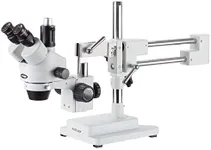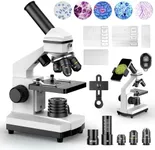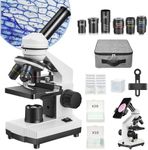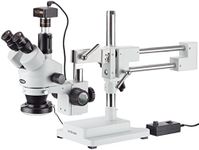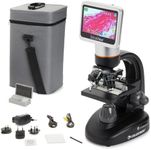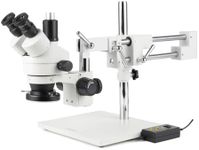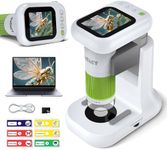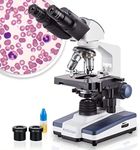Buying Guide for the Best Microscopes
Choosing the right microscope can be a rewarding experience, whether you're a student, hobbyist, or professional. The key is to match the microscope's features to your intended use. Think about what you want to observe—tiny cells, insects, minerals, or electronic components—and how detailed you need the view to be. Understanding the main specifications will help you make a confident and informed decision.MagnificationMagnification tells you how much larger the microscope can make an object appear compared to its actual size. This is important because different tasks require different levels of detail. For example, looking at plant cells might need less magnification than viewing bacteria. Magnification is usually a combination of the eyepiece and objective lens powers. Low magnification (up to 100x) is good for larger specimens like insects, medium (100x-400x) works for cells and tissues, and high (400x and above) is needed for bacteria and fine details. Choose the range that matches what you want to see most often.
Type of MicroscopeThere are several types of microscopes, each suited for different uses. Compound microscopes are best for viewing small, transparent specimens like cells, while stereo (or dissecting) microscopes are ideal for larger, solid objects like insects or circuit boards. Digital microscopes connect to computers for easy viewing and sharing. Think about what you want to observe most and pick the type that fits those needs.
Lighting/IlluminationLighting is crucial for seeing details clearly. Some microscopes use built-in LED or halogen lights, while others rely on natural light. Adjustable lighting lets you control brightness and contrast, which is helpful for different specimens. If you plan to look at transparent samples, a microscope with a light source below the stage (transmitted light) is best. For opaque objects, top lighting (reflected light) is more useful. Consider what you'll be viewing and choose a microscope with the right lighting options.
Objective LensesObjective lenses are the main lenses that provide different levels of magnification. Most microscopes have several objectives that you can rotate into place. The quality and range of these lenses affect how sharp and detailed your images will be. Lower power objectives (4x, 10x) are good for scanning and finding your specimen, while higher powers (40x, 100x) are for detailed viewing. If you need to see a wide range of details, look for a microscope with multiple, good-quality objectives.
Focusing MechanismThe focusing mechanism lets you bring your specimen into sharp view. Coarse focus moves the stage quickly for general focusing, while fine focus allows for precise adjustments. For delicate work or high magnification, fine focus is essential to avoid missing details. If you plan to do detailed or high-magnification work, make sure the microscope has both coarse and fine focusing controls.
Stage and Stage ControlsThe stage is where you place your slides or specimens. Some stages are fixed, while others can be moved smoothly in different directions using knobs. A mechanical stage with controls makes it easier to move your sample precisely, which is especially helpful at high magnifications. If you expect to examine many samples or need to move around your specimen a lot, a mechanical stage is a good feature to have.
EyepieceThe eyepiece is where you look into the microscope. Eyepieces come in different magnifications, usually 10x or 15x, and can affect your overall viewing comfort. Some microscopes have a single eyepiece (monocular), while others have two (binocular) for more comfortable, extended viewing. If you plan to use the microscope for long periods, a binocular eyepiece can reduce eye strain.


